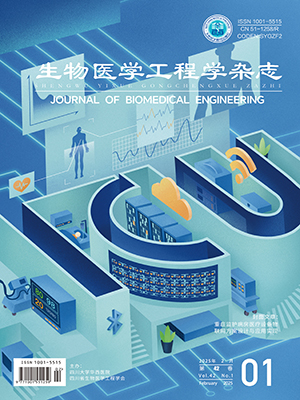| 1. |
曾秋伊, 朱素优. 绒毛染色体核型分析在产前诊断及自然流产中的临床应用. 中国优生与遗传杂志, 2019, 27(6): 679-681.
|
| 2. |
闫梅, 李辉, 陈佛兰, 等. 广东惠州地区 2117 例孕妇羊水染色体结果分析. 检验医学与临床, 2019, 16(15): 2171-2174.
|
| 3. |
Britto A P, Ravindran G. A review of cytogenetics and its automation. J Med Sci, 2007, 7: 1-18.
|
| 4. |
郭宏宇, 鲍旭东, 蒋春涛. 基于模糊人工神经网络的染色体识别. 中国生物医学工程学报, 2004, 23(2): 116-120, 126.
|
| 5. |
蒋欣. 人类染色体图像自动分析技术研究. 武汉: 华中科技大学, 2007.
|
| 6. |
Hu R L, Karnowski J, Fadely R, et al. Image segmentation to distinguish between overlapping human chromosomes. arXiv preprint, 2017. arXiv: 1712.07639.
|
| 7. |
Munot M V. Development of computerized systems for automated chromosome analysis: current status and future prospects. International Journal of Advanced Research in Computer Science, 2018, 9(1): 782-791.
|
| 8. |
Qiu Y, Lu X, Yan S, et al. Applying deep learning technology to automatically identify metaphase chromosomes using scanning microscopic images: an initial investigation//Biophotonics and Immune Responses XI. International Society for Optics and Photonics, San Francisco: SPIE, 2016, 9709: 97090K.
|
| 9. |
Krizhevsky A, Sutskever I, Hinton G E. ImageNet classification with deep convolutional neural networks//Advances in Neural Information Processing Systems. Stateline: NIPS, 2012: 1097-1105.
|
| 10. |
Szegedy C, Liu W, Jia Y, et al. Going deeper with convolutions//2015 IEEE Conference on Computer Vision and Pattern Recognition (CVPR), Boston: IEEE, 2015: 1-9.
|
| 11. |
Simonyan K, Zisserman A. Very deep convolutional networks for large-scale image recognition//International Conference on Learning Representations (ICLR), 2015. arXiv: 1409.1556.
|
| 12. |
He Kaiming, Zhang Xiangyu, Ren Shaoqing, et al. Deep residual learning for image recognition//2016 IEEE Conference on Computer Vision and Pattern Recognition (CVPR), Las Vegas: IEEE, 2016: 770-778.
|
| 13. |
Hu Jie, Shen Li, Sun Gang. Squeeze-and-Excitation networks//2018 IEEE/CVF Conference on Computer Vision and Pattern Recognition, Salt Lake City: IEEE, 2018: 7132-7141.
|
| 14. |
Huang G, Liu Z, van der Maaten L, et al. Densely connected convolutional networks//Proceedings of the IEEE Conference on Computer Vision and Pattern Recognition, Honolulu: IEEE, 2017: 4700-4708.
|
| 15. |
Sharma M, Saha O, Sriraman A, et al. Crowdsourcing for chromosome segmentation and deep classification//2017 IEEE Conference on Computer Vision and Pattern Recognition Workshops (CVPRW), Honolulu: IEEE, 2017: 786-793.
|
| 16. |
Qin Y, Wen J, Zheng H, et al. Varifocal-Net: A chromosome classification approach using deep convolutional networks. IEEE Trans Med Imaging, 2019, 38(11): 2569-2581.
|
| 17. |
Jindal S, Gupta G, Yadav M, et al. Siamese networks for chromosome classification//2017 IEEE International Conference on Computer Vision Workshops (ICCVW), Honolulu: IEEE, 2017: 72-81.
|
| 18. |
Gagula-Palalic S, Can M. Human chromosome classification using competitive neural network teams (CNNT) and nearest neighbor//IEEE-EMBS International Conference on Biomedical and Health Informatics (BHI), Valencia: IEEE, 2014: 626-629.
|
| 19. |
谭凯. 染色体图像智能分析的综合方法研究及应用. 成都: 电子科技大学, 2020.
|
| 20. |
Lin C, Zhao G, Yang Z, et al. CIR-net: automatic classification of human chromosome based on Inception-ResNet architecture. IEEE/ACM Trans Comput Biol Bioinform, 2020, PP. DOI: 10.1109/TCBB.2020.3003445.
|
| 21. |
Poletti E, Grisan E, Ruggeri A. Automatic classification of chromosomes in Q-band images//2008 30th Annual International Conference of the IEEE Engineering in Medicine and Biology Society, Vancouver: IEEE, 2008: 1911-1914.
|
| 22. |
Ioffe S, Szegedy C. Batch normalization: accelerating deep network training by reducing internal covariate shift//International Conference on Machine Learning. Lille: IMLS, 2015: 448-456.
|
| 23. |
Lundsteen C, Lind A M, Granum E. Visual classification of banded human chromosomes. I. Karyotyping compared with classification of isolated chromosomes. Ann Hum Genet, 1976, 40(1): 87-97.
|
| 24. |
Sweeney Jr W P. Musavi M T, Guidi J N Classification of chromosomes using a probabilistic neural network. Cytometry: the Journal of the International Society for Analytical Cytology, 1994, 16(1): 17-24.
|
| 25. |
Piper J, Granum E. On fully automatic feature measurement for banded chromosome classification. Cytometry, 1989, 10(3): 242-255.
|




